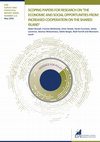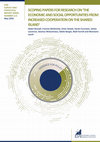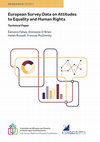Papers by Frances McGinnity
Research in Social Stratification and Mobility, Oct 1, 2022

The mission of the Economic and Social Research Institute is to advance evidencebased policymakin... more The mission of the Economic and Social Research Institute is to advance evidencebased policymaking that supports economic sustainability and social progress in Ireland. ESRI researchers apply the highest standards of academic excellence to challenges facing policymakers, focusing on 12 areas of critical importance to 21st Century Ireland. The Institute was founded in 1960 by a group of senior civil servants led by Dr T. K. Whitaker, who identified the need for independent and in-depth research analysis to provide a robust evidence base for policymaking in Ireland. Since then, the Institute has remained committed to independent research and its work is free of any expressed ideology or political position. The Institute publishes all research reaching the appropriate academic standard, irrespective of its findings or who funds the research. The quality of its research output is guaranteed by a rigorous peer review process. ESRI researchers are experts in their fields and are committed to producing work that meets the highest academic standards and practices. The work of the Institute is disseminated widely in books, journal articles and reports. ESRI publications are available to download, free of charge, from its website. Additionally, ESRI staff communicate research findings at regular conferences and seminars. The ESRI is a company limited by guarantee, answerable to its members and governed by a Council, comprising 14 members who represent a cross-section of ESRI members from academia, civil services, state agencies, businesses and civil society. The Institute receives an annual grant-in-aid from the Department of Public Expenditure and Reform to support the scientific and public interest elements of the Institute's activities; the grant accounted for an average of 30 per cent of the Institute's income over the lifetime of the last Research Strategy. The remaining funding comes from research programmes supported by government departments and agencies, public bodies and competitive research programmes.
Socio-Economic Review, 2006
Helen Russell, Frances McGinnity, Tim Callan and ... Helen Russell is Associate Research Professo... more Helen Russell, Frances McGinnity, Tim Callan and ... Helen Russell is Associate Research Professor, Frances McGinnity is Senior Research Officer, Tim Callan is Research Professor and Claire Keane is Research Assistant at The Economic and Social Research Institute.

The mission of the Economic and Social Research Institute is to advance evidencebased policymakin... more The mission of the Economic and Social Research Institute is to advance evidencebased policymaking that supports economic sustainability and social progress in Ireland. ESRI researchers apply the highest standards of academic excellence to challenges facing policymakers, focusing on 12 areas of critical importance to 21st Century Ireland. The Institute was founded in 1960 by a group of senior civil servants led by Dr T. K. Whitaker, who identified the need for independent and in-depth research analysis to provide a robust evidence base for policymaking in Ireland. Since then, the Institute has remained committed to independent research and its work is free of any expressed ideology or political position. The Institute publishes all research reaching the appropriate academic standard, irrespective of its findings or who funds the research. The quality of its research output is guaranteed by a rigorous peer review process. ESRI researchers are experts in their fields and are committed to producing work that meets the highest academic standards and practices. The work of the Institute is disseminated widely in books, journal articles and reports. ESRI publications are available to download, free of charge, from its website. Additionally, ESRI staff communicate research findings at regular conferences and seminars. The ESRI is a company limited by guarantee, answerable to its members and governed by a Council, comprising 14 members who represent a cross-section of ESRI members from academia, civil services, state agencies, businesses and civil society. The Institute receives an annual grant-in-aid from the Department of Public Expenditure and Reform to support the scientific and public interest elements of the Institute's activities; the grant accounted for an average of 30 per cent of the Institute's income over the lifetime of the last Research Strategy. The remaining funding comes from research programmes supported by government departments and agencies, public bodies and competitive research programmes.

This report maps the data available on attitudes to equality and human rights issues in Ireland c... more This report maps the data available on attitudes to equality and human rights issues in Ireland collected in European surveys over the period 2000 to 2018. These surveys provide a rich source of evidence for researchers and policymakers in Ireland. We identify a total of 1,509 relevant questions from a search of over 125 attitude surveys. These questions are categorised according to the groups and topics addressed. We find that attitudes towards minority ethnic/nationality groups, gender/gender roles and social welfare recipients are the most widely covered. Questions on attitudes towards religious minorities, age groups/ageism, family status, disability and sexual orientation are much less common. Moreover, while the frequency of attitude questions relating to sexual orientation has increased over the period, questions on age and disability groups have declined. Within these equality groups the surveys cover a range of topics including social distance, social contact, tolerance and policy preferences. Questions on experiencing or witnessing discrimination are also regularly included in European questionnaires: a total of 359 such questions are identified over the period studied. Again, coverage is greatest for gender and ethnicity/nationality groups; however, the third most common set of questions concerns discrimination on the basis of sexual orientation. We identify a data gap in discrimination on the grounds of social welfare receipt or social class. Intersectionality-that is the way in which the combination of equality characteristics e.g. gender and ethnicity, may be associated with differential treatment or in this case viewed differently by others-is rarely covered in the surveys we assessed. The research highlights the availability of data that can be analysed to provide insights into where policy efforts to reduce prejudice and discrimination might best be targeted. Analysis of such questions can also highlight which policies are more likely to encounter public resistance or support. The report also discusses some of the strengths and limitations of attitudinal surveys for addressing equality and human rights issues and draws out some lessons for questionnaire design.

Economic and Social Review, Dec 15, 2017
This paper formed part of the conference to mark 50 years of social research at the ESRI. It prov... more This paper formed part of the conference to mark 50 years of social research at the ESRI. It provides an overview of gender equality in the labour market in Ireland over a 50-year period. It takes as its starting point two studies published by ESRI researchers in the early 1970s including a survey of women carried out in 1973. Five themes are identified in these early studies, which are then carried through to the current period. These are: patterns of female labour force participation; gender segregation; sectoral labour demand; attitudes; and appropriate policy responses. The study then outlines how many of the normative, legislative and institutional constraints to women’s employment were removed during the following decades and discusses key educational and fertility trends that influenced labour force participation. Policy responses have also shifted over the period. We find that while there has been distinct change in the normative culture, a major upward shift in the scale of female employment, and a decline in gender segregation, women’s and men’s employment remains strongly gendered.

Journal of the Statistical and Social Inquiry Society of Ireland, Dec 4, 2015
1. INTRODUCTION The extent of the Great Recession in Ireland is well documented. Real GDP fell by... more 1. INTRODUCTION The extent of the Great Recession in Ireland is well documented. Real GDP fell by 10 per cent between 2008 and 2010 (Barrett and McGuinness, 2012). The impact that this large fall in economic activity had on the country's labour market was severe, with Ireland's overall unemployment rate increasing from 4.6 per cent in 2006 to 15 per cent in 2012, (2) while the numbers in employment fell from 68.5 per cent to 58.8 per cent over the same time period. Long-term unemployment also increased considerably from 1.5 per cent in 2006 to 9.2 per cent in 2012. Fortunately, some modest economic growth since 2012 (see Duffy et al., 2014) has resulted in unemployment beginning to fall and increases in employment: by Quarter 1 2015, the unemployment rate stood at 9.9 per cent and the employment rate 62.2 per cent, while the long-term unemployment rate has fallen to 5.9 per cent. (3) The collapse in the property sector was a very significant factor in Ireland's economic downturn, resulting in the highest level of job losses occurring in the construction sector. From peak to trough, construction sector employment fell by 65 per cent between 2007 and 2013. Apart from the information and communication sector, education, health and the arts, all other sectors also experienced a decline in the numbers employed, but none to the extent of the construction sector (see Figure 1 below). There has been considerable debate about where the costs of the recession have fallen across society in terms of social class, income groups, age groups, household types, and by gender (e.g. Barry and Conroy 2013; Callan et al., 2012; Gerlach-Kristen, 2013; Keane et al., 2014; NESC, 2013; TASC, 2012; Whelan et al., 2015). While much of this work has focused on outcomes such as income loss, poverty, debt and financial stress, this paper focuses on the distribution of unemployment effects, given the rapid rise in unemployment that took place with the recession. Unemployment is a key measure of the cost of the recession as it has strong consequences for social cohesion, and impacts directly on income and poverty. The experience of unemployment has been shown to leave 'scars' on future outcomes, such as a person's career and wages, and also their happiness, job satisfaction and health (Arulampalam, 2001; Scarpetta and Sonnet, 2010). However, it must be noted that as a measure of the effect of recession, unemployment has its weaknesses, namely because it excludes those who do not participate. Thus, it does not account for groups who may be marginalised from the labour market; for example, the long term unemployed and inactive. Nevertheless, there is a strong argument against using the unemployment to population ratio as an indicator for unemployment, as using the total population as the denominator includes groups who actively choose to stay out of the labour market, such as stay-at-home mothers. (4) This paper attempts to add to the existing literature on the labour market impact of the Great Recession by focussing on the equality impact of the unemployment crisis. Specifically, we examine how the exposure to unemployment risk varies across five of the equality groups that are covered by the Equality Acts (5)--age, gender, family status, marital status and nationality--before and after the recession. We were unable to examine the impact of the recession on the other four grounds that are covered by the Equality Acts--disability, membership of the Traveller community, religion and sexual orientation--as labour market statistics are not collected on a regular basis for these groups. (6) Previous research has shown that the negative impact of the recession on Ireland's labour market has not been evenly spread across the population (Barrett and Kelly, 2012; Russell et al., 2014 and Kelly et al., 2014). This paper builds on this existing research by incorporating sector information into the analyses and examining its impact on unemployment risk and how this has changed pre and post recession. …
Oxford University Press eBooks, Sep 12, 2013
The Liffey Press eBooks, Nov 18, 2010
... Laurence Bond, Frances McGinnity and Helen Russell ... further Council directives – and conse... more ... Laurence Bond, Frances McGinnity and Helen Russell ... further Council directives – and consequent Irish legislation – on specific issues including social security matters, self-employment, pregnant workers, working time, pa-rental leave, and part-time workers (McCrudden, 2003 ...
Liffey Press eBooks, 2010
Ananthi's research interests lie broadly in the area of intergroup conflict and cooperation. Her ... more Ananthi's research interests lie broadly in the area of intergroup conflict and cooperation. Her research aims to uncover the role that ethno-religious diversity plays in explaining perceptions of intergroup trust and threat, and the extent to which these relationships are moderated by intergroup contact. Laurence Bond has been Head of Research at the Equality Authority since 2002. Prior to this he worked for many years in research and policy analysis in the Irish public and non-government sectors.
Economic and Social Review, 2007
This report is the second publication arising from the “Research Programme on Equality and Discri... more This report is the second publication arising from the “Research Programme on Equality and Discrimination” which is being carried out by the ESRI on behalf of the Equality Authority. This examination of time-use data from the Irish National Time- Use Survey conducted in 2005 seeks to contribute to a deeper understanding of gender equality in Ireland. It examines the distribution of paid and unpaid work between men and women, the differences in the total workloads of women and men and the division of labour within couples.











Uploads
Papers by Frances McGinnity